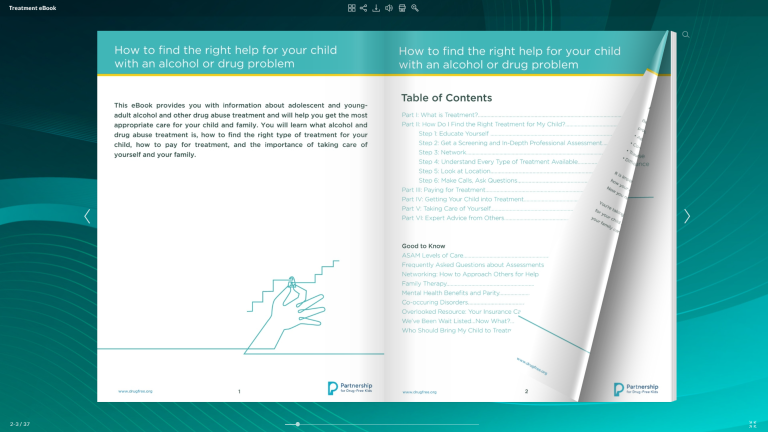What Is Digital Marketing Funnel – Stages, Models & How It Works
Getting conversions is not easy in these days. We strive to find customers everywhere, but convincing people to leave their hard-earned money at our place is difficult.

In this article, we will go over the idea of a digital marketing funnel and how you can use it to your advantage. We’ll also look at how tools like a flipbook maker can boost your content strategy by making your marketing materials more interactive and engaging.
What Is a Digital Marketing Funnel?
A digital marketing funnel is a strategy that uses a sales funnel to optimize conversions. It includes all marketing actions that lead to the conversion, which is turning potential clients into buyers. This could be advertising, creating a landing page, competitive pricing, and such.
The most commonly used model for a digital marketing sales funnel is:
-
Awareness - making the customer aware of your product or service; it is mostly advertising, content creation, etc.
-
Interest - your marketing efforts then need to focus on keeping the customers' interest with a newsletter, social media marketing, and such;
-
Desire - ignite a desire in your prospects to buy a product or service;
-
Action - the action or conversion stage, where the customer takes the desired action like buying a product or service, singing-up for a newsletter, downloading content, or following the company on social media;
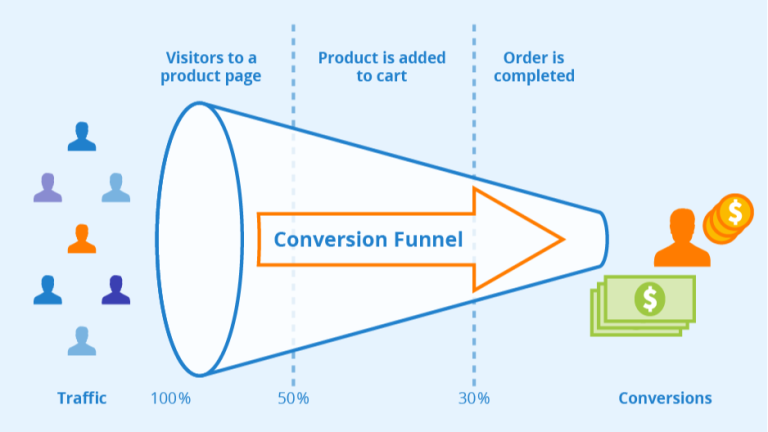
Some add the customer retention part at the bottom of the funnel.
Why a Digital Marketing Funnel Matters
A digital marketing funnel is key to boosting efficiency and providing valuable insight into the customer journey. It can also help you solve problems and help the company grow. In fact, 48% of companies prioritize improving their sales funnels. To ensure your success, you need to use this strategy too. Here are the reasons why:
-
Data-Driven Approach - marketing funnels can provide companies with data on their customer's habits, and demographics and help to make informed decisions for improvement;
-
Leads Generation and Management - a marketing funnel can organize lead generation and help companies manage the process of converting leads to customers; a scattered approach can produce scattered results, so being organized is key for sustainable growth;
-
Reduce Business Challenges - with a marketing funnel, you are able to identify your sales pain points and increase the conversion rates; additionally, a marketing funnel can organize the leads' follow-up process and help you target the relevant audience with a personalized approach;
-
Boost Marketing Efficiency - it is also essential in streamlining your operation; making informed, data-driven decisions can improve your business efforts; tactics like audience segmentations, A/B testing, and customer journey mapping are essential tools that can help companies in growth;
-
Sales Process Gaps - if done correctly, a marketing funnel can highlight potential customer drop-off; it can help companies address weak spots and optimize;
-
Target Audience - a marketing funnel can also help you in mapping the customer journey and giving companies insight into their needs and preferences, which can lead to improving their marketing efforts;
-
Trust and Credibility - with personalized and relevant content that weeds out the customers not interested in your product or service, companies can create a smooth user experience and build trust and credibility in their field;
Benefits of a Digital Marketing Funnel
Now, let's go over some key benefits of a digital marketing funnel. These benefits can vary depending on what you're selling and how you run your business. Even location can impact the effectiveness of a funnel. Nevertheless, here are some of the most common benefits of a digital marketing funnel:
-
Improve Conversion Rates - a marketing funnel can increase your conversion rates; 95% of buyers choose a vendor who provides them with sufficient content that helps them navigate each stage of the buying process; not utilizing a digital marketing funnel will put you aside from the competition;
-
Improve ROI - a digital sales funnel can also improve your Return on Investment (ROI) from your ads and other marketing efforts by bringing customers and establishing brand awareness;
-
Personal Touch - sales funnels are more personal; it's a customer journey suited for the particular person you are catering to; tailored messages and customized advertising can drive conversions and increase engagement.
-
Customer Retention - customers who went through your digital marketing funnel are more likely to stay with your brand. As Medium points out "By personalizing experiences, maintaining engagement, building trust, and rewarding loyal customers, you can turn one-time buyers into long-term supporters."
-
More Leads - with funnel marketing, you can optimize your customer journey and ensure qualified leads that are ready for purchases; a personalized campaign can drive conversions and increase interest;
-
Upselling and Cross-Selling - if you know more about your customer journey, you can upsell or cross-sell products or services to add to the initial conversion;
Key Stages of a Digital Marketing Funnel
Let's now talk about the key stages of a digital marketing funnel that you need to take into account.
-
Top Stage - it's the start of every marketing funnel, where you gather awareness about your product or service;
-
Middle Stage - here is where you add more connections to the brand;
-
Bottom Stage - is where you can expect the conversions to appear;
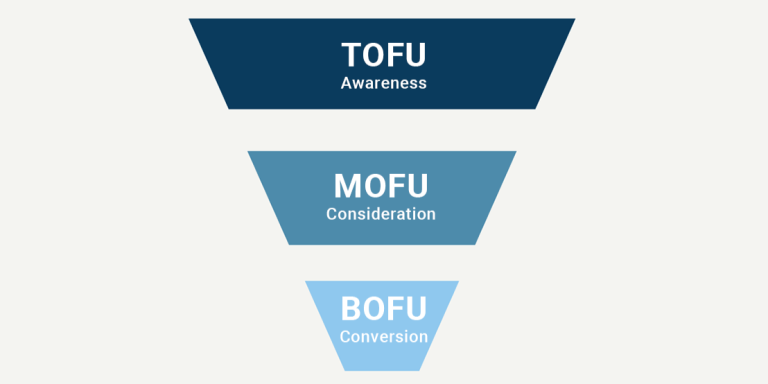
Each one of those digital marketing funnel stages is essential to getting customers, so let's have a closer look at them:
1. Top of the Funnel (TOFU)
The top of the funnel is where your customers are introduced to your products or services. The key is to gather attention and get more brand awareness by presenting your products or services as something that will solve problems. Additionally, make sure to leave a positive impression about your brand and keep an open approach to customers.
2. Middle of the Funnel (MOFU)
The middle of the funnel is where you want to stand out among the competition. Here, you have educate potential customers about the key elements that differentiate you from the competition. Be persuasive, showcase your USPs (Unique Selling Propositions), and slowly guide the customers to the conversion stage.
3. Bottom of the Funnel (BOFU)
This is the conversation stage. After capturing interest, and building trust, it's time to convert leads into buyers. How? Well, it depends on the user's behavior. Give them a free trial. Maybe create a free ebook (it's easy with Publuu!)? A discount for new users? There are a lot of tactics but to close the deal, you need to understand the customer and present them with the answer they were looking for.
Main Models of Digital Marketing Funnels
Now that we know what a digital marketing funnel is, let's go over the most important models we can differentiate:
AIDA Marketing Funnel
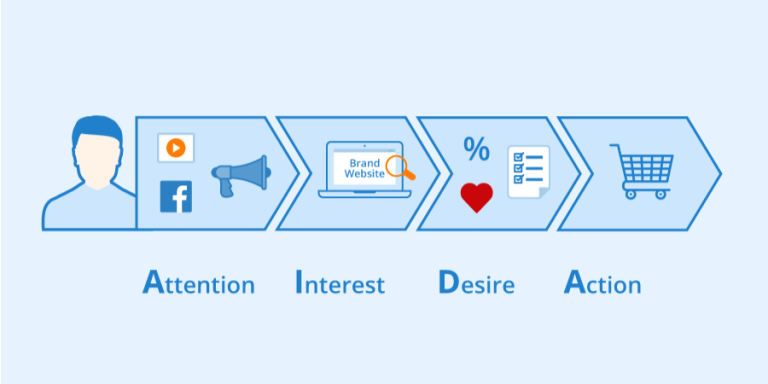
AIDA is one of the most basic, yet extremely popular models. It's an acronym that stands for Awareness, Interest, Desire, and Action.
-
Awareness - you need to make your product or service shine; use PPC campaigns, SEO optimization, and your social media platform to make some noise in the market;
-
Interest - when you get their attention, you need to capture their interest; show them your best side, help them with their problems, and mesmerize them with your quality;
-
Desire - after initial interest, you need to make the customers desire your product or service; highlight the most important features, show that you are better than the competition, and give them something to consider;
-
Action - whatever it may be - your audience has to act! Whether it's a sign-up to a newsletter or buying your product, it's essential to finalize your funnel with some activity on their side;
Hourglass
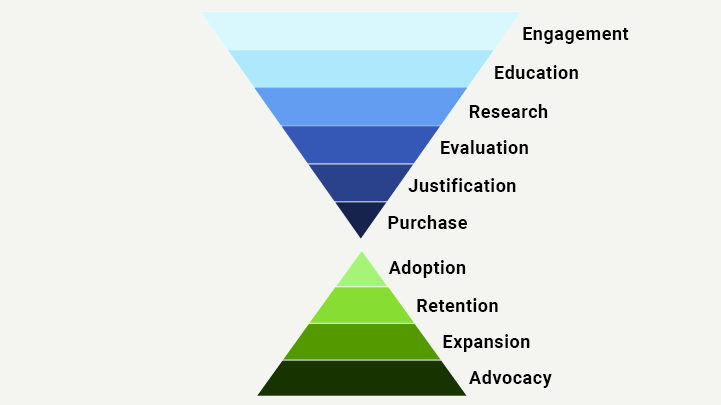
The Hourglass methods have a few steps as well:
-
Engagement - turn some heads and get the customers' attention.
-
Education - show them some interesting facts about your product or service and convince them that it can be a great thing for them.
-
Research - now your potential customers are trying to find some information about your company; make it accessible and easy to navigate.
-
Evaluation - target audience members evaluate your offer compared to all the rest; it can be anything, from price, usability, and quality.
-
Justification - prospects are now trying to justify the decision of the purchase; do they need it? does it look good? is it a good price?
-
Purchase - and now you have gained a new customer; remember to not stretch the payment process with unnecessary questions and pop-ups, as they may begin to have second thoughts.
-
Adoption - customers are now using your products and services, and deciding whether or not it's something for them.
-
Retention - if they like it, they will come back for some more of the same...
-
Expansion - ...or even more! Satisfied customers can even get more products and services and expand their relationship with your business.
-
Advocacy - they can even become brand advocates and recommend your product or service to others.
Looping

The Looping model is similar to the Hourglass method. Here are the stages of looping:
-
Awareness - as with the other methods - be noticeable and stand out.
-
Consideration - your potential customers are considering your product or service compared to all the others.
-
Purchase - your prospects become customers and buy your product.
-
Loyalty - they like it so much that they come for more.
-
Advocacy - and even recommend it to their friends becoming your brand ambassadors.
Micro-Moments
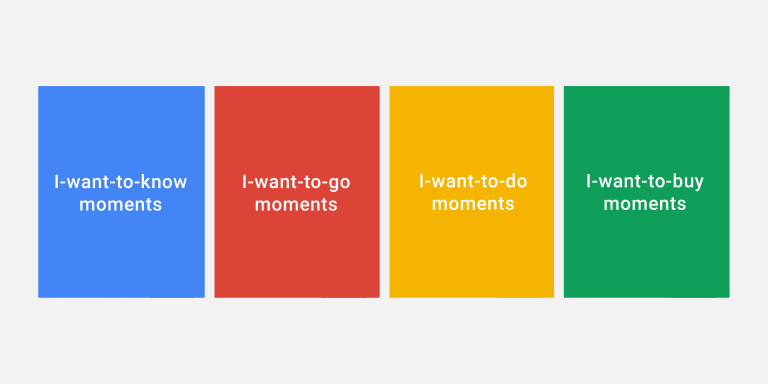
And finally, we have the micro-moments marketing funnel. It can be described with different moments of the customer journey:
-
I-Want-to-Know - exploring/research mode.
-
I-Want-to-Go - when the prospective customers are looking for a business locally.
-
I-Want-to-Do - when your prospects are looking for information on how to accomplish something.
-
I-Want-to-Buy - when your prospective customers become buyers.
How to Create an Effective Digital Marketing Funnel in 10 Easy Steps!
After all this theory, let's go for some practice. Here are 10 easy steps for an effective digital marketing funnel:
Step 1 - Identify Your Target Audience
Every digital marketing funnel strategy starts with identifying who are your customers. How to find that out?
-
Market Research - create focus groups, interview people, find out who would be interested in your product or service.
-
Customer Data - analyze the purchase history and gather data on buying patterns.
-
Buyer Persona - identify the buyer persona of your prospects; what are their demographics, and pain points; Google Analytics tools can help you out with that.
-
Competitor Analysis - find out who are your competitors and who are they catering to.
-
A/B Testing - social media gives you a lot of options when it comes to A/B testing and finding out how different target audiences react to your products and services.
-
Keyword Research - it's a method of finding out relevant keywords that people search for in Google (mostly); it's essential for SEO optimization, but it can also guide you to finding out what are your demographics and how to cater to them.
![]() Read more: How to find target audience
Read more: How to find target audience
Step 2 - Set Marketing Goals
Planning is the key to success, so focus on the most effective strategies to achieve your business goals. There are a couple of elements you can use in order to make it easier for yourself.
-
SMART Method - it's the most basic method, but one of the most effective; here, you need to make sure that your goals are Specific, Measurable, Achievable, Relevant, and Time-Bound.
-
Business Objectives Alignment - you need to remember that your marketing efforts should be in line with your business objectives and brand strategy.
-
KPIs - create Key Performance Indicators to see whether or not your goals are being implemented.
-
Set Milestones - make sure that you are achieving the milestones of your marketing goals so that you and other stakeholders will get the feeling of accomplishment after each phase and will be able to see the bigger picture.
-
Focus on the End Goal - remember to have an end goal in mind whenever you set your marketing goals, so that you will not be distracted by everyday changes.
-
Review - review the whole process and come up with new solutions; the marketing world is always changing so you have to be prepared for everything and always up to date.
Step 3 - Create Awareness
Make yourself visible! The most common tactics are:
→ PPC (Pay-Per-Click) marketing with Google Ads or Social Media
→ SEO (Search Engine Optimization)
→ Influencer Marketing
→ Traditional Media Marketing
→ Landing page optimization
The main goal is to be as loud and visible as possible among all your marketing channels.
Step 4 - Get More Traffic
After people find out about your brand, you need to process them to your website. It can be done with paid advertising and PPC campaigns. Similarly to what you have done in step 3, you need to find the optimal path to actually transfer your prospective customers to your website. It can be done, for example, by:
-
Creating interesting content that people will come to see.
-
PPC campaigns for targeted audiences.
-
Paid advertising in traditional media.
-
CTA (Call-to-Action) e.g. Buy now!.
-
Offering discounts on-site.
-
Create more traffic by sharing a flipbook made in Publuu on various forums, guest posts on specialized websites, etc.
![]() Want to know more? Check how to optimize your flipbook for SEO
Want to know more? Check how to optimize your flipbook for SEO
Step 5 - Qualified Leads
After getting to your landing page, your customers need to know what to do. Optimize your landing page, use CTAs, and strategically place lead capture forms in order to generate sales. Here are some tactics you can utilize:
-
Eye-Catchers - place eye-catching widgets on your website in strategic places to turn leads into sales;
-
Be available - ensure that the payment process is easy, secure, and accessible.
-
Chatbots - add chatbots that can guide prospective customers through the process.
-
Quid-pro-Quo - offer potential customers some freebies in exchange for their information like e-mail or phone number.
-
A/B testing - find out what works and what does not for different audiences; see if your CTAs are doing the job or if you need to change things up.
-
Cordial approach - create a personalized vibe; if you have gathered some cookies from your clients, don't hesitate to write a script with their name popping up on the screen.
-
Publuu - creating flipbooks with Publuu allows you to add lead forms directly within your publication, helping you engage readers and collect information.
Step 6 - Leads Engagement
After getting sales-qualified leads, make sure to engage them and communicate with them regularly. Nurture them with new campaigns, create newsletters, and personalize your messages based on users behavior. Monitor how they respond to your efforts. Ensure that you keep them engaged but don't overbear them with information so that they would not treat you as spam.
Step 7 - Leads Conversion Stage
Another important element is finishing the customer journey with a successful sale. How to do it? It depends on what you're offering. Elements like CTAs (Buy now!), free trials, and exclusive offers are some of the elements that will work in most cases. Additionally, remember to build rapport with your customers. Show them all your certificates, 5-star reviews, and everything you feel would convince them to get your products.
Step 8 - Finish the Sales Process
The worst thing you can do is to overcomplicate the purchasing process. To develop greater customer satisfaction and actually get sales, make it as easy as possible for customers to purchase a product or a service.
Don't create unnecessary pop-up windows with thousands of questions. If there's anything between the customer and the purchase, it will give them time to change their mind or lose interest.
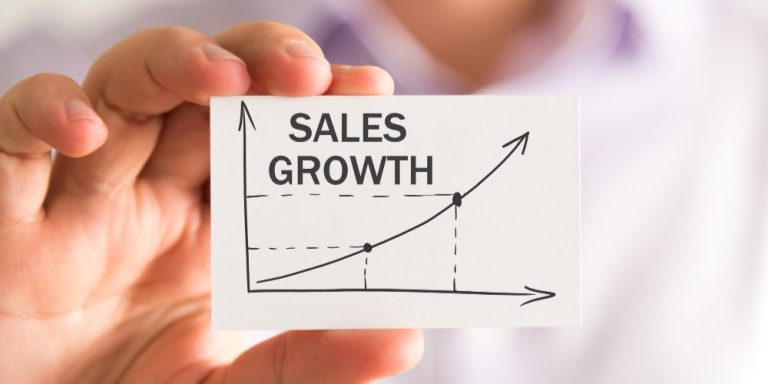
Additionally, make sure to give your customers all the payment options available on the market and a chatbox to answer their questions in real-time. And - since data protection is crucial these days - reassure your customers that their data is being stored properly.
Step 9 - Customer Retention and Upselling
The next step involves post-sale best practices. To retain customers, create loyalty programs, and referral discounts, and regularly check customer satisfaction. Additionally, offer them some new services for a good price. Encourage them to get an even better package.
Ensure you have excellent customer service. Make your employees/team members understand that satisfied customers are key to the company's growth.
Step 10 - Review and Revise
Finally - review the whole thing every now and then and revise the solutions implemented. Check if your KPIs are performing well, as well as all the other critical metrics. Make sure to review the whole process regularly, check the customer feedback, and conduct market research into new trends in the market.
Remember to test things out and try new solutions. Those who do not advance get left behind, so keep yourself in line with the industry trends.
Best Contents for Each Stage of the Digital Marketing Funnel
Let's now go over the best content for every stage of a digital marketing funnel. Of course, it will all depend on the type of business you are running, but those are some of the most common strategies to keep in mind.
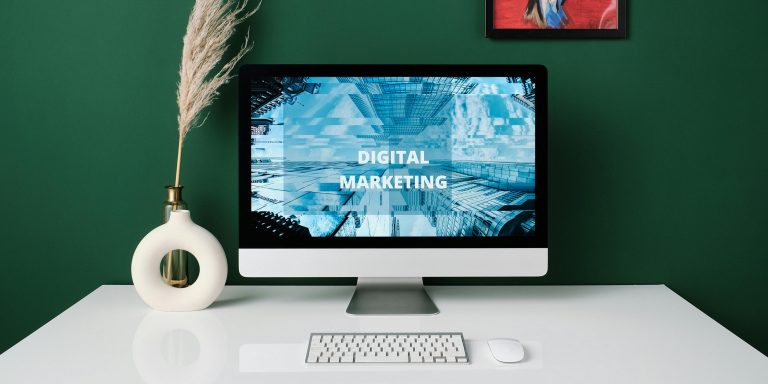
Top of the Funnel
To bring awareness to your brand, you need to consider below methods:
-
PPC Campaign - go for Google Ads, as it's the most effective on the market; nevertheless, don't forget about social media campaigns as well, where you can get some traffic for a lower price.
-
Search Engine Optimization - make sure that your landing page is created with the SEO best practices in mind; the second page of Google does not exist for most people, so make sure to put yourself next to the relevant keywords.
-
Influencer Marketing - it's a great way to encourage new customers to check out your brand; they have incredible reach and can bring a lot of traffic to your website.
To keep the interest of your prospects, we recommend:
-
Landing page optimization - if you have a clear and interesting website, people will stay there longer and check out new products and services by browsing through it.
-
Content marketing - you can prospects keep them engaged and have them stay on the website even longer. Remember to add CTAs and ask for contact information.
![]() Related topic: How to Become a Content Creator
Related topic: How to Become a Content Creator
Middle of the Funnel
Here, you need to show the customers that you can solve their problems. To create a desire, you should present your prospects with convincing arguments on why they should choose you. Use marketing tactics such as:
→ Creating FAQs.
→ Showing your successes (great customer reviews, certificates).
→ Presenting benefits of your products or services (you SAVE money with X).
Bottom of the Funnel
To push your leads towards the purchase you can use a few tactics - site optimization. CTAs, links to purchase, etc. A great way of doing it even better is to add remarketing to your tools portfolio. That way, your leads, even after leaving your site, will get notifications on other websites about your products and services.
Remarketing can result in conversion rates over 200% higher than those of conventional ads, so make sure to use it to your benefit.
Customer Retention
Customer retention is focused on getting back your customers, making them brand ambassadors, or upselling and cross-selling products and services to them. It's essential to keep them engaged, as lasting customers are the best advertisement for your brand. Here are some tactics you can use to keep them coming:
-
Email marketing - if you have their emails, you can send newsletters, invites to webinars, or Publuu flipbooks with the latest news in your field.
-
Loyalty programs - people appreciate being rewarded for their loyalty; if they come back to your business often, give them special discounts or rewards that they can use for your product or service.
Sales Funnel Examples: What Works and What Doesn’t
Now, let's get on with some examples! Here are the most successful and unsuccessful examples of sales funnels.
Lead Magnet → Nurture Sequence → Offer
It's simple - create a lead magnet (a free eBook for example), and get an email address in exchange. Then, during the Nurture Sequence, show the value of your products and services with the (Offer) possible explanation of a paid subscription.
Why does it work? Well, you are totally upfront. You have to build trust with your prospects by providing value first, rather than expecting their loyalty upfront. You have created a relationship and provided an additional offer of paid service or product.
Webinar Funnel
Webinars are great when it comes to generating leads. People who attend webinars usually are already interested in the topic. So, at the end of every webinar, after convincing them that you know what you're talking about, you can offer them a consultation or a product.
You have built a relationship with your potential customers, built the authority of an expert in their eyes, and followed up with (usually) time-limited offers to gain conversions.
Tripwire Funnel
The tripwire funnel is based on the simple idea of upselling. First, you offer your customers a high-value product for a low cost after they visit your website. Next, after the purchase, you add higher-ticket products to the offer. For example, you can get simple video editing software for a cheap price, but with an expansion, you gain a watermark-free version with the the caption-creation feature.
Free Trial Funnel
And finally, among those strategies that actually work, we have the free trial element. We have all seen it before. 14-day free trial to get your customers hooked on the product, give them a taste of the quality so that they will actually feel like they can't live without it.
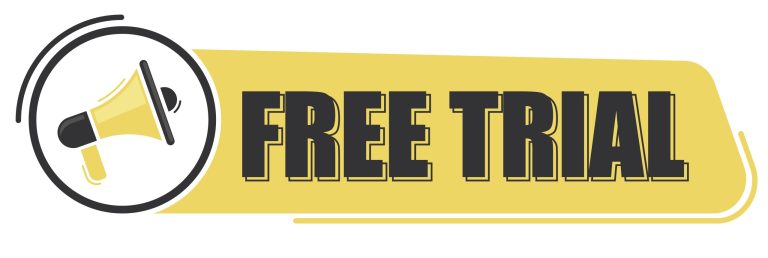
Generic Email Campaigns
It's an unimaginative email marketing funnel giving you a 10% discount on a product that you don't even know. There is no personalization in this strategy, the same message to thousands of people - it's just not good enough to keep the business running.
Too Much Going On
Another bad idea is to create a funnel that is doing too much to gather customers. If you have dozens of emails from one company, their website is filled with hundreds of pop-ups, multiple forms, and a disgusting amount of check-ins - it's safe to assume that people will likely opt out of this business.
Lack of Proposition
And finally, if you don't really know what you are offering to your customers, they will not know as well! If you have a free ebook, but it's not a good value product, but something that you just happen to have the rights to - people will not be interested in what you're providing. Even more, if you don't have a specific product and service to provide - people will leave your site in an instant.
Unclear message is the worst thing you can do to your business. If you have so many things to offer and you just put them all out there - you will not see success. To optimize - make sure to have a clear message and choose the one option that you feel is the most important for your customers. And then - work from that point on.
Traditional Marketing Funnel vs. Digital Marketing Funnel
Let's now go over the differences between a traditional marketing funnel versus a digital one. There are a lot of similarities, but there are a couple of differences that should be explained.
→ Traditional Marketing Funnel has a linear progression. In a traditional "store", for example, you sometimes need to just have a place at the right spot. You have a customer coming to your shop, they saw an ad on TV, they come in, pick their product from the shelf and leave. Pretty simple.
→ Digital marketing funnel has multiple funnels working for you at the same time. The main goal of the digital marketing funnel is to reduce churn. So, in order to keep them engaged constantly, digital marketing is showing different types of customers and different types of products.
That way, the customers will remain on the website and not migrate to the competition. Each type of customer will have a different journey to the landing page, will view a different side of your business, and have a completely different interaction with your products and services.
Digital Marketing Funnel vs. Sales Funnel
Another important distinction is to diversify the digital marketing funnel and sales funnel. It boils down to what is the end goal of each one of those. The sales funnel is about turning prospects into customers.
Digital marketing funnel, on the other hand, aims to create a whole array of benefits for the company. From brand awareness, through customer satisfaction aspect, ending with creating personalized experience.
It's key to align both of those in order to create a full-funnel strategy that will not only give you more customers but can also benefit the perception of your brand. Stakeholders from both teams can work together in order to grow the company and get even more customers.
Create Your Strategy Using Publuu
But how to create a digital marketing funnel strategy? Well, if you're wondering, we have a treat for you! Create a flipbook with all the key information for all the stakeholders with Publuu! It's the leading flipbook maker in the market with online presentation tools that will help you in creating an informative and entertaining strategy.
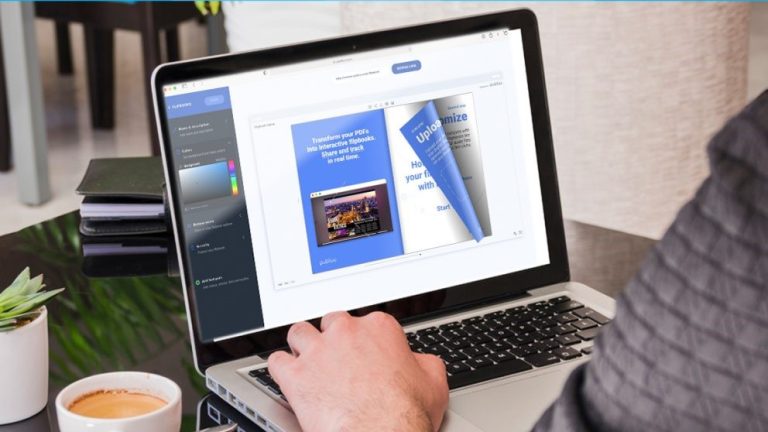
Additionally, you can create your very own digital magazine, online brochures, and even ebooks with Publuu's help! If you want to get more leads for your digital marketing funnel - Publuu is the way to go!
Conclusion
As the authors of Digital Marketing Fundamentals state:
"Over the past decades, the framework of marketing has changed dramatically. Internet use has become part of the daily routine for most people. It has radically transformed the behavior of consumers and business buyers."
We live in the digital world. If you have a business, you have to be online. You just cannot miss out on such an opportunity. A digital marketing funnel is a great way to optimize your online presence even further. It's a personalized approach with a great success rate that the giants in the industry use. You have seen it with Netflix, Adobe, and Groupon. They all utilize funnel marketing to, well, the fullest.
We hope that you got some quality information out of this article. If you liked this one, make sure to check out other articles on our site. There are quite a lot of them, so we are positive that you will find something to your liking. That's it for today! See you in the next one!
You may be also interested in:
What is Branding? Simple Guide
Creative Low Cost Marketing Ideas For Your Business
